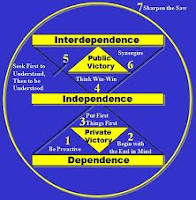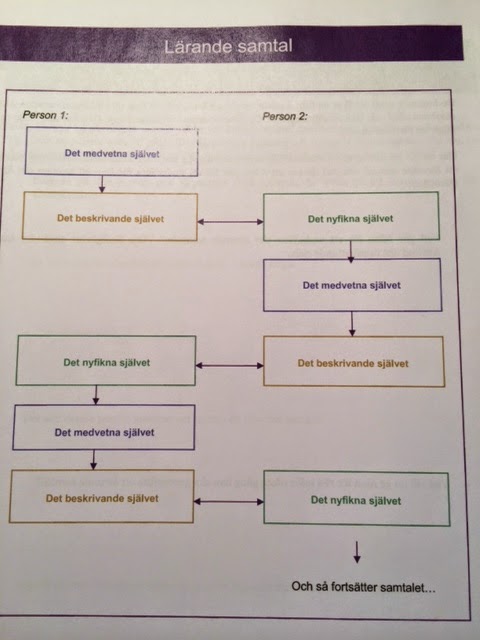Seven habits - the public victory
 I would like to share my exformative summary of "the public victory" from the book "The seven habits of highly effective people - powerful lessons in personal change" by Stephen R. Covey. To see my exformative summary of the private victory, click here.
I would like to share my exformative summary of "the public victory" from the book "The seven habits of highly effective people - powerful lessons in personal change" by Stephen R. Covey. To see my exformative summary of the private victory, click here.The public victory is all about interdependance ...
THINK WIN/WIN
Stephen Covey defines six paradigms of human interaction: Win/Win, Win/Lose, Lose/Win, Lose/Lose, Win, Win/Win or No Deal. The Win/Win paradigm is a frame of mind and heart, meaning that agreements or solutions should be mutually beneficial, mutually satisfying. Win/Win is a belief in the Third alternative. It´s not your way or my way; it´s a bettter way, a higher way.
The principle of Win/Win embraces five interdependant dimensions of life. It begins with character and moves toward relationships, out of which flow agreements. It is nurtured in an environment where structure and systems are based on Win/Win. And it involves process; we cannot achieve Win/Win ends with Win/Lose or Lose/Win means.
- Character: There are three character traits essential to the Win/Win paradigm; Integrity - meaning you have to keep commitments to yourself as well as to other, Maturity - is the balance between courage and consideration ("I´m okey, you´re okey" in transactional analysis language), Abundance mentality - saying that there is plenty out there for everybody, recognizing the unlimited possibilities for positive interactive growth and development.
- Relationships: The trust (the Emotional Bank account) is the essence of Win/Win. You make deposits into the Emotional bank account through genuine courtesy, respect, and appreciation for that person and for the other point of view.You listen more, you listen in greater depth.You express yourself with greater courage.
- Agreements: In the Win/Win agreement the following five elements are made very explicit; Desired results (not methods), Guidelines specify the parameters, Resources identify the support available, Accountability sets up the standards of performance and the time of evaluation and Consequences specify what will happen as a result of the evaluation.
- Supportive systems: You get what you reward. If you want to achieve the goals and reflect the values in your mission statement, then you need to align the reward system with these goals and values. If it isn´t aligned systematically, you won´t be walking your talk. For Win/Win to work, the systems have to support it. The training system, the planning system, the communication system, the budgeting system, the information system, the compensation system - all have to be based on the principle of Win/Win.
- Processes: You need to separate the person from the problem, to focus on interests and not on positions, to invent options for mutual gain, and to insist in objective criteria - some external standard or principle that both parties can buy into.
This principle is the key to effective interpersonal communication, bases on principles of empathic communication.
There are four different types of communication, reading and writing, speaking and listening. The ability to do them well is absolutely critical to your effectiveness. If you want to interact effectively with me, to influence me, you first need to understand me. The real key to influence me is your example, your actual conduct. Your example flows naturally out of your character, or the kind of person you truly are. Your character is constantly radiating, communicating. From it I come to instinctively trust or distrust you and your efforts with me.
When another person speaks, we´re usually "listening" at one of four levels. We may be ignoring another person, not really listening at all. We may practice pretending. "Yeah. Uh-huh. Right". We may practice selective listening, hearing only certain parts of the conversation (e.g listening to the constant chatter of a preschool child), or we may practice attentive listening, paying attention and focusing energy on the words that are being said.
But very few of us practice the fifth level, the highest form of listening - empathic listening:
Empathic listening gets inside another person´s frame of reference. You see the world the way they see the world, you understand how they feel. The essence of empathic listening is that you fully, deeply, understand that person, emotionally as well as intellectually.
Communication experts estimate that only 10 percent of our communication is represented by the words we say, another 30 percent is represented by our sounds, and 60 percent by our body language. In empathic listening, you listen with your ears, but you also listen with your eyes and with your heart. You listen for feeling, for meaning. You listen for behaviour. You use your right brain as well as your left. You sense, you intuit, you feel. You are focused on recieving the deep communication of another human soul.
Diagnose before you prescribe. This is also true in sales. An effective sales person first seeks to understand the needs, the concerns, the situation of the customer. The amateur salesman sells products; the professional sells solutions to needs and problems. The professional learns how to relate people´s needs to his products and services.
We tend to have four autobiographical responses:
We evaluate - we either agree or disagreer; we probe - we ask questions from our own frame or reference; we advise - we give counsel based on our own experience; or we interpret - we try to figure people out, to explain their motives, their behaviour, based on our own motives and behaviour.
Instead, we should learn how to listen with empathy. The skills, the top of the iceberg of empathic listening, involves four development stages:
1. mimic content; is all about listening to the words that come out of someone´s mouth and you repeat them
2. rephrase the content; is when you put his meaning into your own words
3. reflect feeling; is about paying as much attention to what he´s saying as you are to the way he feels about what he is saying
4. rephrase the content and reflect the feeling; is when you are able to use both sides of your brain to understand both sides of the communication (feeling and content). This opens a soul to soul flow. He begins to trust you with his innermost tender feelings and thoughts.
The above skills is important to know. But, remember that the skills will not be effective unless they come from a sincere desire to understand. And, you will discover tremendous differences in perception, understanding the impact that these differences have when people try to work together in interdependant situations.
Seek first to understand... then to be understood.
Knowing how to be understood is equally critical in reaching Win/Win solutions. Seeking to understand requires consideration; seeking to be understood takes courage. The early Greeks had a philosophy (ethos, pathos and logos) that contain the essence of making effective presentations.
Ethos is your personal credibility, the faith people have in your integrity and competency. Pathos is the empathic side - it´s the feeling. Logos is the logic, the reasoning part of the presentation. Most people, in making presentations, go straight to the logos, the left brain logic, of their ideas. They try to convince other people of the validity of that logic without first taking ethos and pathos into consideration. To be successful, you should present your own ideas clearly, specifically, visually, and most important, contextually - in the context of a deep understanding of the other parties paradigms and concerns.
Finally, habit 5 is right in the middle of your Circle of Influence. The more deeply you seek to understand other people, the more you will appreciate them, the more reverent you will feel about them. To touch the soul of another human being is to walk on holy ground.
SYNERGIZE
Synergy is the essence of principle-centered leadership. It catalyzes, unifies, and unleashes the greatest power within people. Simply defined, it means that the whole is greater than the sum of its parts.
It takes an enormous amount of internal security to begin with the spirit of adventure, the spirit of discovery, the spirit of creativity. You have to leave the comfort zone of base camp and confront an entirely new and unknown wilderness. Synergy is everywhere in nature. The challenge is to apply the principles of creative cooperation, which we learn from nature, in our social interactions. The essence of synergy is to value differences - to respect them, to build on strengths, to compensate for weaknesses.
Synergistic communication is simply about opening your mind and heart and expressions to new possibilities, new alternatives, new options. Synergy is exciting. Creativity is exciting. It´s phenomenal what openness and communication can produce. Synergy means that 1+1 may equal 8, 16, or even 1600. The synergistic position of high trust produces solutions better than any originally proposed, and all parties know it.
The combination of thinking Win/Win and seeking first to understand, creates the ideal environment for synergy. Buddhism calls this "the middle way". Middle in this sense does not mean compromise; it means higher, like the apex of the triangle.
The essence of synergy is to value the differences, even within ourselves. When a person has access to both the intuitive, creative, and visual right brain, and the analytical, logical, verbal left brain, then the whole brain is working. In other words, there is psychic synergy taking place in our own head. And this tool is best suited to the reality of what life is, because life is not just logical - it is also emotional.
Valuing the differences is the essence of synergy - this means you have to realize that all people see the world, not as it is, but as they are. The person who is truly effective has the humility and reverence to recognize his own perceptual limitations and to appreciate the rich resources available through interaction with the hearts and minds of other human beings. Is it logical that two people can disagree and that both can be right? It´s not logical: it´s psychological. And it´s very real.
In an interdependant situation, synergy is particularly powerful in dealing with negative forces that work against growth and change. Kurt Lewin has developed a "Force field analysis" model in which he described any current level of performance or being as a state of equilibrium between the driving forces that encourage upward movement and the restraining forces that discourage it. When you introduze synergy, you create an atmosphere in which it is safe to talk about the restraining forces. You unfreeze them, loosen them up, and create new insights that actually transform those restraining forces into driving ones. You involve people in the problem, immerse them into it, so that they soak it in and feel that it is their problem and they tend to become an important part of the solution.
All nature is synergistic. Ecology is a word which basically describes the synergism in nature - everything is related to everything else. It´s in the relationship that creative powers are maximized, just as the real power in these Seven Habits is in their relationship to each other, not just in the individual habits themselves.
When you see only two alternativs - yours and the "wrong one" - you can look for a synergistic third alternative, and if you work with a Win/Win philosophy and really seek to understand, you usually can find a solution that will be better for everyone concerned.


Kommentarer
Skicka en kommentar